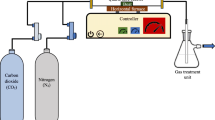Abstract
Decomposition reactions during torrefaction start at 563 K, as shown by thermogravimetric analysis (TGA), as determined by pretests. Based on these findings, different biochars were produced by torrefaction at 563 K, combined with increasing holding times (10–40 min). The fuel properties of biochar products were investigated by means of calorific value, ultimate analysis, true density, and scanning electron microscopy (SEM). The maximal increase in the calorific value of biochar occurred at about 20 min, which correlated positively with its carbon contents. More consistently, the true densities of the resulting biochar end products increased mostly within the holding time ranging from 10 to 20 min, which we proposed as the best process window for torrefaction of coffee residue. At longer holding time (>20 min), we observed a shrinking of biochar by SEM, making it more friable or brittle. It may involve more hemicellulose depolymerization, leading to a porous and corrugated structure.





Similar content being viewed by others
References
Demirbas A (2001) Biomass resource facilities and biomass conversion processing for fuels and chemicals. Energy Convers Manag 42:1357–1378
Demirbas A (2008) Hazardous emissions from combustion of biomass. Energy Source A 30:170–178
Acar S, Ayanoglu A (2012) Higher heating values (HHVs) of biomass fuels. Energy Educ Sci Technol A 28:749–758
Klass DJ (1998) Biomass for renewable energy, fuels, and chemicals. Academic Press, San Diego
McKendry P (2002) Energy production from biomass (part 2): conversion technologies. Bioresour Technol 83:47–54
Basu P (2010) Biomass gasification and pyrolysis: practical design and theory. Academic Press, San Diego
Brewer CE, Schmidt-Rohr K, Satrio JA, Brown RC (2009) Characterization of biochar from fast pyrolysis and gasification systems. Environ Prog Sustain Energy 28:386–396
Cantrell KB, Hunt PG, Uchimiya M, Novak JM, Ro KS (2012) Impact of pyrolysis temperature and manure source on physicochemical characteristics of biochar. Bioresour Technol 107:419–428
Lee Y, Eum PRB, Ryu C, Park YK, Jung JH, Hyun S (2013) Characteristics of biochar produced from slow pyrolysis of Geodae-Uksae 1. Bioresour Technol 130:345–350
Ronsse F, Hecke SV, Dickinson D, Prins W (2013) Production and characterization of slow pyrolysis biochar: influence of feedstock type and pyrolysis conditions. GCB Bioenergy 5:104–115
Deng J, Wang GJ, Kuang JH, Zhang YL, Luo YH (2009) Pretreatment of agricultural residues for co-gasification via torrefaction. J Anal Appl Pyrolysis 86:331–337
Pimchuai A, Dutta A, Basu P (2010) Torrefaction of agriculture residues to enhance combustible properties. Energy Fuels 24:4638–4645
Ciolkosz D, Wallace R (2011) A review of torrefaction for bioenergy feedstock production. Biofuels Bioprod Bioref 5:317–328
Acharya B, Sule I, Dutta A (2012) A review on advances of torrefaction technologies for biomass processing. Biomass Converg Bioref 2:349–369
Arias B, Pevida C, Fermoso J, Plaza MG, Rubiera F, Pis JJ (2008) Influence of torrefaction on the grindability and reactivity of woody biomass. Fuel Process Technol 89:169–175
Tsai WT, Liu SC, Hsieh CH (2012) Preparation and fuel properties of biochars from the pyrolysis of exhausted coffee residue. J Anal Appl Pyrolysis 93:63–67
Bustin RM, Mastalerz M, Wilks KR (1993) Direct determination of carbon, oxygen, and nitrogen content in coal using the electron microprobe. Fuel 72:181–185
Acknowledgments
Sincere appreciation was expressed to acknowledge the Instrumentation Centers at National Chung Hsing University and National Pingtung University of Science and Technology for the assistances in the elemental analysis and SEM observation, respectively.
Author information
Authors and Affiliations
Corresponding author
Rights and permissions
About this article
Cite this article
Liu, SC., Tsai, WT., Li, MH. et al. Effect of holding time on fuel properties of biochars prepared from the torrefaction of coffee residue. Biomass Conv. Bioref. 5, 209–214 (2015). https://doi.org/10.1007/s13399-014-0139-1
Received:
Revised:
Accepted:
Published:
Issue Date:
DOI: https://doi.org/10.1007/s13399-014-0139-1




